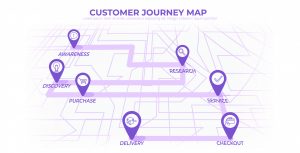Ah, the customer journey – that coveted path to purchase that every business wants to know about their buyers.
How did your customers discover your business? How long did it take for them to sign up for something or purchase from you? What content did they consume along the way? These questions seem simple enough, but for businesses everywhere, the answers can be elusive and often inaccurate.
Perhaps the most effective way to answer these questions is to literally ask every customer as they make their purchase(s), but that’s not always feasible or subjectively realistic. An alternative, then, is to track your customers’ journey. Sometimes this is accomplished with a visual aid – the customer journey map.
This concept is exactly as it sounds. The customer journey map shows the path a prospect follows to take that important next step with your business, whether that be downloading something, joining a rewards club, or making a purchase.
 Using a customer journey map correctly not only answers the questions of when and where your customers originate from, but it also becomes a resourceful tool to continue defining and segmenting your audience and predicting future tendencies.
Using a customer journey map correctly not only answers the questions of when and where your customers originate from, but it also becomes a resourceful tool to continue defining and segmenting your audience and predicting future tendencies.
Customer Journey Mapping 101
Don’t worry, you don’t have to be a cartographer or an artist (but if you’re either, rock on!) to create the actual map. Depending on the type of map you want to use, there are many templates available online, or you can create your own with Google sheets, Excel, or even just a pen and paper. In any case, all you’re really doing is highlighting the different touchpoints that a prospect experiences on their way to whatever you want them to do. When you can visualize this process, you can tailor your content at each point along the path to give your customer the best experience possible.
Considering the way content – whether organic, paid, or earned – is distributed and consumed these days, the path to purchase is rarely linear. Customers research in their own way and tend to bounce around a lot. Then when you factor in referrals and even impulse actions, their journey isn’t clearly defined, hence the usefulness of the map.
First, start by defining your goal. Do you want your customers to sign up for something? Fill out a form? Call your business? Or make a purchase?
When you have this goal set, list the traditional stages of the buying process as a starting point and assign relevant touchpoints to each stage. These can include social media, display ads, emails, your website, blog, a phone call, or even a store visit – any way that the prospect interacts with your business counts.
Next, look at the data you’ve collected (you are monitoring those analytics, aren’t you?) and highlight any pain points the customer may be having at each stage. Often, this information and other valuable data can be gathered through surveys, questionnaires, and feedback from your sales staff or customer service reps. Getting to know what is keeping the customers from stopping at one point or taking the next step at another, is crucial.
Over time, you’ll be able to use the insights you’re gathering to populate the pain points on the map itself and the picture will become clearer as to how you can adjust your offerings, services, and even internal processes to guide the customer through their buying journey. Is the price too high? Announce a sales incentive. Mis-timed interaction? Refocus your customer service initiatives. Not enough form fills or content downloads? Re-examine the content + audience alignment (more on this to come).

An Outside-In Approach
If you’ve successfully mapped out your customer journey to the point where you have good (or new) knowledge of your customers’ path, that’s a great start. Now, almost as a bonus, you can use that information to turn your efforts inward and focus on some inbound marketing strategies to complement your outbound reach.
Because you understand how to provide interesting and helpful information for your customers (and what they don’t particularly like) out in the world, you can now update your owned & operated assets (website, social media, events you host or attend, etc.) with that same kind of aligned content to attract customers to you – and keep them.
Effective mapping sheds light on what your customers want and you’ll see how that can help shape your marketing efforts in many ways moving forward.
